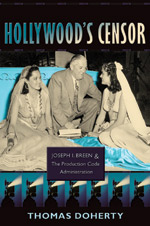(Columbia University Press, 496 pages, $29.50)
By Thomas Doherty
 Although he never directed a millimeter of film footage himself, the man at the heart of this book left a deep and indelible mark on every movie that Hollywood made between 1934 and 1954. In those years, Joseph Breen’s work essentially functioning as chief censor and morals cop as the head of the studios’ Production Code Administration (also known as the Hays Code). He was responsible for establishing hard and fast laws for what could and could not be depicted on screen. This ranged from dead bodies to double beds, and to ensuring, blue pencil in hand, that scripts didn’t violate these laws (a process known as “Breening”). He was also the point man between the Catholic Church, the most active and powerfully censorious religious entity of the era, and the insecure, still partially unassimilated Jewish moguls who ran the studios. That insecurity was evident by their turning over moral invigilation to the servant of an occasionally anti-Semitic religious denomination.
Although he never directed a millimeter of film footage himself, the man at the heart of this book left a deep and indelible mark on every movie that Hollywood made between 1934 and 1954. In those years, Joseph Breen’s work essentially functioning as chief censor and morals cop as the head of the studios’ Production Code Administration (also known as the Hays Code). He was responsible for establishing hard and fast laws for what could and could not be depicted on screen. This ranged from dead bodies to double beds, and to ensuring, blue pencil in hand, that scripts didn’t violate these laws (a process known as “Breening”). He was also the point man between the Catholic Church, the most active and powerfully censorious religious entity of the era, and the insecure, still partially unassimilated Jewish moguls who ran the studios. That insecurity was evident by their turning over moral invigilation to the servant of an occasionally anti-Semitic religious denomination.
Doherty gives us the greatest hits of the Breen years—excising rude words in Preminger’s The Moon Is Blue, covering Jane Russell’s unconstrained breasts in The Outlaw, and so on. He offers a rounded portrait of his glad-handing Irish-American protagonist, but the book is greatly enhanced by the detailed historical perspective Doherty brings to his examination of relations between American Judaism and Catholicism at a time when World War II was brewing and the election of a Catholic president was still some years off. As he points out, this helps explain both the noticeable dearth of movies about Jewish issues in that period, and the simultaneous surfeit of Catholic-themed films such as Going My Way, Boys Town, Angels with Dirty Faces, and the oddly devout oeuvre of Loretta “Attila the Nun” Young. Built on a solid foundation of archival research, Doherty nonetheless delivers his portrait in a sprightly, reader-friendly style, making Breen and his complex, vanished times come alive with contemporary resonance.
Review written by John Patterson.